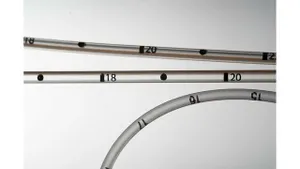Ask the Extrusion Expert: You pose questions, the Extrusion Expert answers
We're proud that Allan Griff, independent consulting engineer and plastics extrusion expert, agreed last year to be the host of our Extrusion Expert webinar series. The series has been a phenomenal success measured on audience attendance, participation and comments, as processors from throughout the world have benefited from Allan's wry and insightful look at their most vexing challenges, and the solutions he has learned in more than 40 years of extrusion.
September 6, 2011
Given that, we are doubly pleased that Allan has agreed to author a weekly column here at PlasticsToday. The formula is simple: readers send questions; Allan chooses the best or most intriguing and answers them. He is much too modest to do so but I nevertheless have given his column the straightforward name "Ask the Extrusion Expert."
Will he answer every question sent? He shouldn't; Allan is an independent consultant and earns his living solving plastics processors' problems. But we still encourage your questions and, knowing Allan and how much he loves helping others who share his passion for plastics, he will answer more than is probably good for business. We will not publish your name or company name unless you expressly ask us to do so, but also will not accept anonymous questions as this opens the opportunity for a supplier to send a "baiting" question for which the answer might highlight his products.
To start the column, we will publish, in the next weeks, attendees' questions plus Allan's answers from our latest Extrusion Expert webinar on "Plastics Chemistry for Non-Chemists." If you were not one of the nearly 400 processors who attended, I can strongly recommend watching the recording and downloading the slides; here is a link to that archived Extrusion Expert webinar (and the topic and presentation was one for the entire industry, not only for extruders).
Without further ado, here are the first few questions, with Allan's answers. These questions are very broad in nature, as was the topic of that lastwebinar, but as this column evolves our hope is it becomes the leading source of extrusion information on the web. Have a plastics extrusion question for Allan? Send it to him at [email protected].
Q: Is Teflon sensitive to water when heated in the same way as PET?
A: No, Teflon and the related fluoroplastics are addition polymers much like polyethylene. No water is driven off in its polymerization (as with PET and the other condensation polymers) so there is no place the water can return to.
Q: Our processors tell us that PVC is dangerous to mold. Is this true?
A: Like almost any manufacturing or sports or driving a car or even cooking in a kitchen, it is dangerous if carelessly done.
They are probably referring to the fact that very hot PVC will emit fumes of hydrochloric acid, which may corrode unprotected mold surfaces and even steel parts outside the mold. This may be avoided by keeping melt temperatures as low as possible, using enough stabilizer in the formulation, and ventilating the area well.
In extrusion, stainless steel tooling may be used, but even regular steel is OK if the formulation is stable, the melt is kept moving, not too hot, and the line stopped and cleaned before too much degradation occurs. Some other plastics (PDVC, some fluoroplastics) do need special materials of construction, usually nickel-based.
If the PVC is plasticized (softened, as in flexible hose or wire insulation) there is much less of a problem, as the plasticizer allows much lower melt temperatures.
As for personal safety, hydrochloric acid (gas) is very irritating and usually drives people away before too much damage occurs. The best practice is to avoid its emission in significant amounts by the above-mentioned actions.
Q: Can we regrind and reuse polycarbonate?
A: Yes, you can, but you have to be careful to avoid moisture in the melt phase, just like with virgin materials, by dehumidifying, drying or equivalent. The limiting problems with reuse of PC, as with all reuse of scrap, may be the increased likelihood of contamination, which may compromise physical strength, and the likelihood of discoloration (yellowing) that may or may not be important, depending on the application.
Q: Is control of the length of the polymer chain done to manipulate the polymer mechanical and visco-elastic properties?
A: Yes, that is a primary effect: longer chains = stronger material and higher melt viscosity, but these things can also be manipulated by the branching on the chains, the distribution, the co-monomers that may be used, and the additives that are included.
By distribution I mean whether most molecules are of a similar length, or whether there is a greater variety in length. For example, if we have ten people in a room and 1 is 1m50cm tall, 8 are 1m60cm tall and 1 is 1m70cm tall, we have a "narrow" distribution. If we have 1 at 1m10cm, 2 at 1m35cm, 4 at 1m60cm, 2 at 1m85cm and 1 at 2m10cm, we have a "broad" distribution, even though the average height of both groups is 1m60cm.
Q: Do nylon products become "softer" as they absorb the moisture in the air?
A: Yes, they do, as the water acts as a plasticizer. Nylons can absorb between 1% and 2% of their weight, depending on the type of nylon and the surrounding humidity and temperature. That is why physical properties like tensile and impact strength should be reported with their test conditions; often two values are reported, one very dry and the other at some controlled humidity/temperature.
Q: You asked how do we know these molecular structures ... how many carbons, how many hydrogen, chlorine?
A: The monomers (building blocks) are known structures - for example, each ethylene is CH2=CH2, which are 2 carbons and 4 hydrogens. If we connect 7 of these as in my slide/drawing, we must have 14 carbons and 24 hydrogens. If we connect 1000 ethylenes, then we have 2000 carbons and 4000 hydrogens.
The same principle applies to other more complicated polymers. Sometimes we have to account for lost water (2 hydrogens and 1 oxygen) for each bond, as in the last few drawings.
However, most people don't need to know the numbers of atoms, as they are more concerned with the properties, which do depend on the way all those atoms are put together, as well as how many there are.
Q: You asked if plastic products are based on petroleum by-products.
A: Not exactly. The major commodity materials such as PE, PP and PS are mostly petroleum-based, except for PVC, which is 56% chlorine, which makes this plastic the least dependent on oil sources, and also requires the least energy to process. It's unfortunate that the ones who are so quick to consider PVC an environmental evil don't see these environmental benefits as well.
There are also some lower-volume plastics whose material source is not petroleum-based, such as the oldest plastic (cellulose nitrate) and its relatives cellulose acetate, acetate-butyrate and propionate. Nylon 11 and some nylon 10 are also in this class, as they are based on castor oil. Recently, many more plant-sourced plastics have been developed that use corn, sugar or other biomass as their starting point. Some are bioactive (degradable or compostable) and some are identical to their oil-based twins, PE and (soon) PP.
However, even with plant-based sources, making the monomers and polymers may rely on petroleum or natural gas for the required energy, so it isn't only the sources that count.
Finally, there are many non-polymeric components of plastics which are not directly petroleum-based, such as wood fibers and glass, but these too have their energy requirements (especially to melt glass to make the fibers) and these energies may well be petroleum-based.
About the Author(s)
You May Also Like


